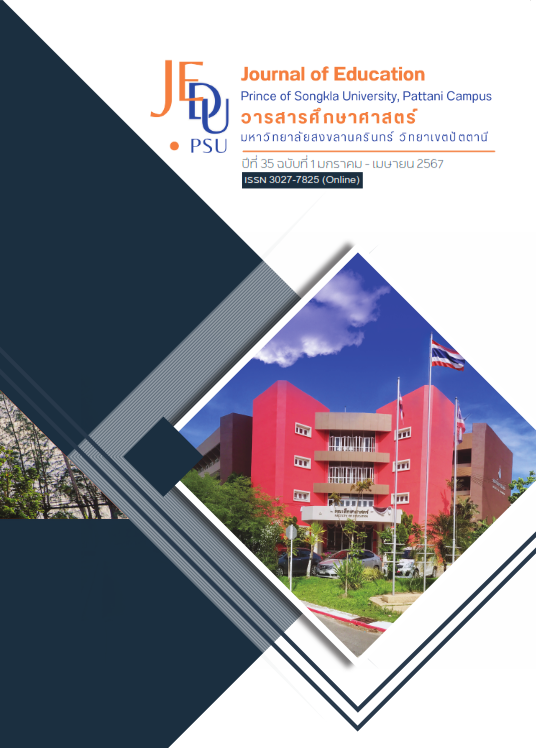การวิเคราะห์นโยบายทางการศึกษาเชิงวิพากษ์: แนวคิด และกระบวนการ
Main Article Content
บทคัดย่อ
บทความมีเป้าหมายเพื่อนำเสนอกรอบแนวคิดเกี่ยวกับการวิเคราะห์นโยบายเชิงวิพากษ์ที่มุ่งให้ความสำคัญกับความเท่าเทียมที่เกิดขึ้นกับทุกภาคส่วนในด้านการศึกษา โดยแบ่งออกเป็น 5 ประเด็นหลัก ได้แก่ 1) การวิเคราะห์นโยบายทางการศึกษา 2) การวิเคราะห์นโยบายทางการศึกษาเชิงวิพากษ์ 3) กรอบการวิเคราะห์นโยบายทางการศึกษาเชิงวิพากษ์ 4) งานวิจัยที่เกี่ยวข้องกับการวิเคราะห์นโยบายทางการศึกษาเชิงวิพากษ์ 5) ข้อจำกัดในการวิเคราะห์นโยบายทางการศึกษาเชิงวิพากษ์ ทั้งนี้ สามารถนำกรอบการวิเคราะห์นโยบายเชิงวิพากษ์ที่ถูกสังเคราะห์ขึ้นนี้มาใช้พิจารณาถึงผลการดำเนินนโยบายทางการศึกษาต่าง ๆ ที่มุ่งเน้นให้เกิดความเท่าเทียมและลดความเหลื่อมล้ำด้านการศึกษาและพัฒนาคุณภาพการศึกษาของประเทศไทยในปัจจุบันและอนาคตภายใต้ข้อจำกัดและข้อเสนอแนะที่กล่าวไว้
Article Details

อนุญาตภายใต้เงื่อนไข Creative Commons Attribution-NonCommercial 4.0 International License.
เอกสารอ้างอิง
Ahmed, I. K. & Dantata, B. S., (2016). Problems and Challenges of Policy Implementation for National Development. Research on Humanities and Social Sciences, 6(15), 60-65.
Ball, S. J. (1994). Education reform: A critical and post-structural approach. Open University Press.
Baumgartner, F. R., Green-Pedersen, C., & Jones, B. D. (2006). Comparative studies of policy agendas. Journal of European public policy, 13(7), 959-974.
Cheng, Y. C., & Cheung, W. M. (1995). A framework for the analysis of educational policies. International Journal of Educational Management, 9(6), 10-21
Cochran, C. E., Mayer, L. C., Carr, T. R., Cayer, N. J., & McKenzie, M. (2012). American public policy: An introduction. Wadsworth, Cengage Learning.
Cooper, R. (2004). Hard power, solf power and goals of diplomacy. In: D. Held & M. Koenig-Archibugi, (Eds). Smerican Power in the 21st Century. Polity Press.
Diem, S., Young, M. D., Welton, A. D., Mansfield, K. C., & Lee, P. (2014). The intellectual landscape of critical policy analysis. International Journal of Qualitative Studies in Education, 27(9), 1068-1090.
Diem, S., & Young, M. D. (2015). Considering critical turns in research on educational policy. International Journal of Educational Management, 29(7), 838-850.
Diem, S. (2017). A critical policy analysis of the politics, design, and implementation of student assignment policies. In M. D. Young & S. Diem (Eds.), Critical approaches to education policy analysis: Moving beyond tradition (pp. 43-62). Springer International Publishing.
Eppley, K. (2009). Rural schools and the highly qualified teacher provision of No Child Left Behind: A critical policy analysis. Journal of Research in Rural Education, 24(4), 1-11.
Fernández, E., & López, G. R. (2017). When parents behave badly: A critical policy analysis of parent involvement in schools. In M. D. Young & S. Diem (Eds.), Critical approaches to education policy analysis: Moving beyond tradition (pp. 111-130). Springer International
Publishing.
Fischer, F. (2003). Reframing public policy: Discursive politics and deliberative practices. Oxford University Press.
Fowler, A. (2000). The quality of aid and development partnership. Focus, 63, 9-11.
George, R. C., Maier, R., & Robson, K. (2020). Ignoring race: A comparative analysis of education policy in British Columbia and Ontario. Race Ethnicity and Education, 23(2), 159-179.
Hallsworth, M., Parker, S., & Rutter, J. (2011). Policy Making in the Real World: Evidence and Analysis, Institute for Government, UK.
Howlett, M., & Ramesh, M. (2003). Studying public policy: Policy cycles and policy subsystems. Oxford University Press.
Kretchmar, K. (2014). Democracy (in) action: A critical policy analysis of New York City public school closings by teachers, students, administrators, and community members. Education and Urban Society, 46(1), 3-29.
Lasswell, H. D. & Kaplan, A. (1970). Power and Society. Yale University press.
Levinson, B. A. U., Sutton, M., & Winstead, T. (2009). Education policy as a practice of power: Theoretical tools, ethnographic methods, democratic options. Educational Policy, 23, 767–795.
Llewellyn, J., Hancock, G., Kirst, M. & Roeloffs, K.A. (1982). Perspective on Education in Hong Kong: Report by a Visiting Panel. Hong Kong Government Printer.
Malley, M. P., & Long, T. A. (2017). Public educational policy as performance: A queer analysis. In M. D. Young & S. Diem (Eds.), Critical approaches to education policy analysis: Moving beyond tradition (pp. 63-82). Switzerland.
Mansfield, K. C., Welton, A. D., & Grogan, M. (2014). “Truth or consequences”: A feminist critical policy analysis of the STEM crisis. International Journal of Qualitative Studies in Education, 27(9), 1155-1182.
McDonnell, L. M. (2009). A political science perspective in education policy analysis. In G. Sykes, B. Schneider, & D. N. Plank (Eds.), Handbook of education policy research (pp. 57-70). New York, NY: Routledge.
Mondy, R. W., Sharplin, A. & Flippo, E. B. (1988). Management: Concepts and Practices. Allyn and Bacon.
Morrow, R. A, & Brown, D. D. (1994). Critical theory and methodology. Sage Publications.
Milani, M., & Winton, S. (2017). Ontario’s fourth ‘r’: A critical democratic analysis of Ontario’s fund-‘r’aising policy. In M. D. Young & S. Diem (Eds.), Critical approaches to education policy analysis: Moving beyond tradition (pp. 193-214). - Springer International Publishing.
Mestry, R. (2014). A critical analysis of the National Norms and Standards for School Funding policy: Implications for social justice and equity in South Africa. Educational Management Administration & Leadership, 42(6), 851-867.
Popkewitz, T. S. (2000). Educational knowledge: Changing relationships between the state, civil society, and the educational community. SUNY Press.
Rodcharoen, P. (2002). Project Management. Netikun Printing. [in Thai]
Sanrattana, W. (2000). Educational policy process from the political system to the bureaucracy: Problems, Obstacles and Solution. Thiphayawisut. [in Thai]
Srisa-an, W. & Wongsothon, T. (2008). Policy concepts and principles. Publisher, Department of Education, Sukhothai Thammathirat University. [in Thai]
Taylor, P.C., & Taylor, E. (2019). Transformative STEAM education for sustainable development. Proceedings of the Science and Mathematics International Conference (SMIC), November 2-4, 2018. Taylor & Francis.
Thamrongthanyawong, S. (2002). Public Policy: Concepts, Analysis and Process. (8th ed.). Sematham Publication. [in Thai]
Thrupp, M., & Tomlinson, S. (2005). Introduction: Education policy, social justice and ‘complex hope’. British Educational Research Journal, 31(5), 549-556.
Welton, A. D., Harris, T. O., Altamirano, K., & Williams, T. (2017). The politics of student voice: Conceptualizing a model for critical analysis. In M. D. Young & S. Diem (Eds.), Critical approaches to education policy analysis: Moving beyond tradition (pp. 83-110). Springer.
Young, M. D., & Diem, S. (Eds.) (2017). Introduction to critical policy analysis. In M. D. Young & S. Diem (Eds.), Critical approaches to education policy analysis: Moving beyond tradition (pp. 1-13). Switzerland: Springer International Publishing.
Young, M. D., & Reynolds, A. L. (2017). Critically examining policy workers and policy work within state boards of education. In M. D.
Young & S. Diem (Eds.), Critical approaches to education policy analysis: Moving beyond tradition (pp. 19-42). Switzerland: Springer
International Publishing.


